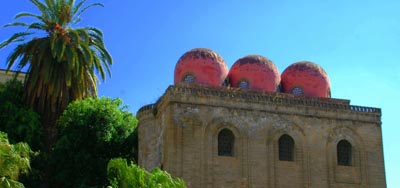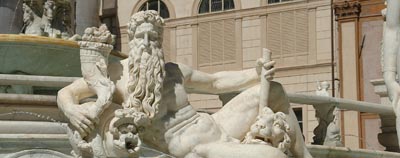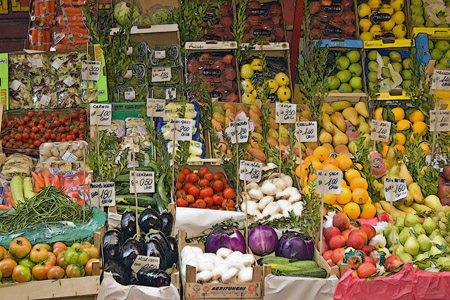Discovering Palermo
A great city to discover, with perfect people and climate for the best year abroad. If you are open and like to have fun, and you like discovering new places, then you have to go.
Palermo
Palmero, the capital of Sicily, is a hidden jewel, that has so much history to discover. Although some quite unfortunate events have happened there, natural disasters such as earthquakes, real estate speculation, poverty, unemployment, and the Mafia resides there. But if we ignore these points that have no impact on the true Palermo, it is amazing city filled with old stone buildings, and so much more than makes Palermo shine brightly.
This photo is taken from the Osservatorio Astronomico di Palermo and is a panoramic of the periphery of Palermo. Sicily's capital has a large population (more than 800 000 residents), making it one of the most populated and culturally rich cities in the old Mediterranean.
Despite it being such a disjointed city, Palermo has quite a regular layout, with narrow streets, and some really long ones. It isn't too bad to get around, although if you are hoping to get round it all in one day, it isn't possible!
If we consider its size and layout in the hope of visiting all of its attractions, there is a guideline of which areas to visit and which to avoid.
You can follow guidelines to visit different sites and areas in historical order, according to certain styles, or simply because of geographical proximity. Of course, if you want, you can simply wander and discover the city by finding hidden quarters and squares on your own.
The interesting thing about this city is that because historically, the city's conquerors were so diverse, both Arab and Norman traditions can be seen on the same monuments, such as the "San Giovanni degli Eremiti" church, the great cathedral, "Palacio Normando y Capillas Palatina", or the "Quattro Canti" square where the two main roads of the city meet; Vittorio Emmanuele and Via Maqueda.


Heading towards to the sea, either from Monreale, or from the highway exit, you get to Palermo via Via Calatafami, a really long avenue that gives us an idea of the size of the city. On either side of the road (poorly signposted which is normal in Sicily), there are two tourist attractions that are completely different to each other. Firstly, there is the "Catacumbas de los Capuchinos" located in a monastery of the same name, famous for its preserved mummies. They have lasted all this time because of the caves effective conservation technique and you can see the dead "dissected" mummies. Secondly, there is the "Zisa", a Norman Palace which has Arab architecture that was recently renovated. It was once the residence of the Norman kings who ruled Sicily in Palermo.
Following Corso Calatafimi, you will get to the Porta Nuova, next to the Norman Palace, an arch built in 1460 to act as the main entrance into Palermo along Via Vittorio Emanuele. Its arch is covered with tiles, it is however a reform of the Mannerist style in 1535, promoted by the Viceroy Colonna to commemorate the triumphal arrival of the Emperor Charles V after the victory in Tunisia. When it was restored in 1696 after it had been damaged by an earthquake, 4 Moor statues were added.
As you continue, you will find the Villa Bonanno on the right, with Sclafani Place located in one of the corners (today the Military Command headquarters stands there) and the Hospital San Giacomo on the right.
Continue on the road and on the right, you will find the Cathedral Square. The cathedral building itself has changed many times over the years, however, it has not lost its grace and charm. It has been a Christian basilica, an Arab mosque and a Christian church for the Normans. Two arches link it to the bell tower, making it a beautiful panoramic photo.

Without getting lost along Ariadna Vittorio Emanuele, when wandering around the shops, keeping on track amongst the heavy traffic of cars, motorcycles, rickshaws, pedestrians, carts, etc., you should arrive at "Quattro Canti" (Piazza Vigliena). Crossing Via Maqueda, Emanuelle opens up into a quiet space which is aligned with four building façades from the 18th century where you will see three statues of the four seasons, the Spanish kings, and the four holy Palermitan of each district.

At night, you have to visit the Square Pretoria, surrounded by the Palazzo Senatorio, the current city hall and the magnificent Church of Santa Caterina. In the centre of the square, younger locals of Palermo gather at the fountain whilst tourists take photos of the impressive buildings.
At the end of the Pretoria Square, you will find the Plaza Bellini, surrounded by the Old Theatre and a Pizzeria, and the beautiful Norman church "La Matorana" as well as the 'Church of San Cataldo'.
Across Vittorio Emanuele, between the narrow streets, you will find the fascinating Vucchiria market. Its name derives from the French word, boucherie, which means butchers. It started between the 10th and 12th century, around the Caracciolo Square and the Vía Argenteria. Fruit stands, cooked fish, meat, cheeses, spices, bargains, etc... it is magical to see it during the evening when the stalls put on their huge spotlights and their red tents are lit up. The mixture of different smells and colours is incredible and just unforgettable.

You can also take a look around the International Puppet Museum, with displays of puppets from around the world, emphasising the 'Sicilian puppis'.
The cultural sites of the capital of Sicily include the "Politeama Theatre" and the "Massimo Palermo Theatre" in the nineteenth century. The Archaeological Museum of Palermo displays all kinds of historical findings, focusing on the remains found in excavations over the island.

Standing out in the distance is Monte Pellegrino and just below "Afrancesado de la Favorita Park", the green area of the city. If you keep going, you will find "Mondello Beach" where the locals go in the summer to swim and to party in the evenings.
11km from Palermo, you will find "Monreale", which is a must-visit. Its Benedictine monastery, magnificent cathedral and its cloisters are one of the best things examples of Arab-Norman art in Sicily.
Content available in other languages
- Español: Descubrir Palermo
Want to have your own Erasmus blog?
If you are experiencing living abroad, you're an avid traveller or want to promote the city where you live... create your own blog and share your adventures!
I want to create my Erasmus blog! →
















Comments (0 comments)